About baseball
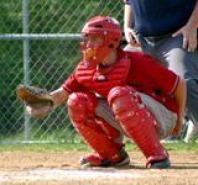
Baseball is a bat-and-ball sport played between two teams of nine players each. The goal of baseball is to score runs by hitting a thrown ball with a bat and touching a series of four markers called bases arranged at the corners of a ninety-foot square, or diamond. Players on one team (the offense) take turns hitting while the other team (the defense) tries to stop them from scoring runs by getting hitters out in any of several ways. A player on offense can stop at any of the bases and hope to score on a teammate's hit. The teams switch between offense and defense whenever the team on defense gets three outs. One turn on offense for each team constitutes an inning; nine innings make up a professional game. The team with the most runs at the end of the game wins.
Baseball on the professional, amateur, and youth levels is popular in North America, Central America, parts of South America, parts of the Caribbean, and parts of East Asia and Southeast Asia. The modern version of the game developed in North America beginning in the eighteenth century. The consensus of historians is that it evolved from earlier bat-and-ball games, such as rounders, brought to the continent by British and Irish immigrants. By the late nineteenth century, baseball was widely recognized as the national sport of the United States. The game is sometimes referred to as hardball in contrast to the very similar game of softball.
In North America, professional Major League Baseball teams are divided into the National League (NL) and American League (AL). Each league has three divisions: East, West, and Central. Every year, the champion of Major League Baseball is determined by playoffs culminating in the World Series. Four teams make the playoffs from each league: the three regular season division winners, plus one wild card team. The wild card is the team with the best record among the non–division winners in the league. In the National League, the pitcher is required to bat, per the traditional rules. In the American League, there is a tenth player, a designated hitter, who bats for the pitcher. Each major league team has a "farm system" of minor league teams at various levels. These teams allow younger players to develop as they gain on-field experience against opponents with similar levels of skill.
Baseball in Serbia
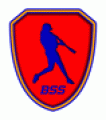
First baseball club in Serbia is founded in 1988. at Belgrade sport society „Partizan“. Unfortunatelly, this club didn’t last for a long time, but shortly afterwards in the beggining of the 90’s strats founded at other clubs, first in Belgrade, then in Novi Sad. First club founded in central Serbia ic a BC Sleepers-Kragujevac, unfortunatelly not for long. Baseball competitions started in 1993., gathering all serbian clubs and made systems and procedures in competitions. In 1997. Serbian Baseball Union becomes part of Europian Baseball Confederation and a right to participate in international competitions.
------------------------------------------------------------------------------------------------------------------------------
In Kingdom of Yugoslavia first club founded was Split „Nada“ in 1932., US Navy in 1914. in Split promoted baseball for a first time in a mutual state - Yugoslavian region.
------------------------------------------------------------------------------------------------------------------------------
In the begining of the 80’s Yugoslavian baseball really „rocks“ eith new clubs founding in Slovenia and Croatia, and after that in Serbia. At the moment, there are two leagues, „Avirex“ Baseball League – ABL and First League of Serbia here. In premier „Avirex“ Baseball League are five clubs and three in First League. Beside league competitions, ther is a traditional anual Belgrade Tournament for children who are 16-year old. Serbia has a representative in interregional Inter League C Belgrade ’96, where clubs from Slovenia, Croatia and Hugary also compete. Beside eight clubs participating in league competitions, there are more clubs, from Novi Sad, Čačak and Kraljevo, and founding in Kragujevac, Valjevo and Prigrevica.
Serbian leagues
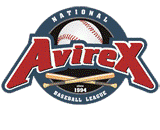
In 2007. prime national „Avirex“ Baseball League of Serbia - ABL has five crews, while First Serbian League has three crews. ABL plays by tri-cirrcular system. In autumn, 1st and 2nd of league department play serie (best of 7) for a chamion. Other crews play „play out“ with first ranked crew of First Serbian League. First two crews of play out will playz in ABL next year, while 3rd and 4th crew play First Serbian League. First Leagu of Serbia consist of 3 crew and each crew plays 8 games. Every weekend one crew is a last to the other crew. First League of Serbia games play 7 substitutes or 5 if there is 10 or more difference and games are limited on 2 hours. The First League plays „play out“. Om all cpmpetitions under SBU, at the beginning of each game the national anthem of Serbia is played. Competition comissioner is Filip Ačanski, and his assistant is Nikola Vučević.
AVIREX BASEBALL LEAGUE: BK Beograd'96 - Beograd; BK Vojvode - Zemun; BK Vojvodina - Novi Sad; BK Dogs - Beograd; BK Bečkerek Gradnulica - Zrenjanin.
1ST LEAGUE OF SERBIA: BK Angels - Čačak; BK Juniori - Beograd; BK Niš - Niš.
Baseball Rules & Regulations
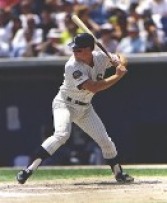
Baseball is played between two teams of nine players each on a baseball field, under the authority of one or more officials, called umpires. There are usually four umpires in major league games; up to six (and as few as one) may officiate depending on the league and the importance of the game. There are four bases. Numbered counter-clockwise, first, second and third bases are cushions (sometimes informally referred to as bags) shaped as 15 in (38 cm) squares which are raised a short distance above the ground; together with home plate, the fourth "base," they form a square with sides of 90 ft (27.4 m) called the diamond. Home base (plate) is a pentagonal rubber slab known as simply home. The playing field is divided into three main sections:
The infield, containing the four bases, is for general defensive purposes bounded by the foul lines and within the grass(or AstroTurf) line (see figure).
The outfield is the grassed area beyond the infield grass line between the foul lines, and bounded by a wall or fence.
Foul territory is the entire area outside the foul lines.
The pitcher's mound is located in the center of the infield. It is an 18 foot (5.5 m) diameter mound of dirt no higher than 10 inches (25.4 cm). Near the center of the mound is the pitching rubber, a rubber slab positioned 60 feet 6 inches (18.4 m) from home plate. The pitcher must have one foot on the rubber at the start of every pitch to a batter, but the pitcher may leave the mound area once the ball is released. At the college/professional level, baseball is played in nine innings in which each team gets one turn to bat and try to score runs while the other pitches and defends in the field. High school baseball plays seven innings and Little League uses six inning games. An inning is broken up into two halves in which the away team bats in the top (first) half, and the home team bats in the bottom (second) half. In baseball, the defense always has the ball — a fact that differentiates it from most other team sports. The teams switch every time the defending team gets three players of the batting team out. The winner is the team with the most runs after nine innings. If the home team is ahead after the top of the ninth, play does not continue into the bottom half. In the case of a tie, additional innings are played until one team comes out ahead at the end of an inning. If the home team takes the lead anytime during the bottom of the ninth or of any inning thereafter, play stops and the home team is declared the winner. The basic contest is always between the pitcher for the fielding team, and a batter. The pitcher throws—pitches—the ball towards home plate, where the catcher for the fielding team waits (in a crouched stance) to receive it. Behind the catcher stands the home plate umpire. The batter stands in one of the batter's boxes and tries to hit the ball with a bat. The pitcher must keep one foot in contact with the top or front of the pitcher's rubber — a 24" x 6" (~ 61 cm x 15 cm) plate located atop the pitcher's mound — during the entire pitch, so he can only take one step backward and one forward in delivering the ball. The catcher's job is to receive any pitches that the batter does not hit and to "call" the game by a series of hand movements that signal to the pitcher what pitch to throw and where. If the pitcher disagrees with the call, he will "shake off" the catcher by shaking his head; he accepts the sign by nodding. Each team has a different set of signals, though the number 1 is almost universal as a fast ball. The catcher's role becomes more crucial depending on how the game is going, and how the pitcher responds to a given situation. Each pitch begins a new play, which might consist of nothing more than the pitch itself.
Each half-inning, the goal of the defending team is to get three members of the other team out. A player who is out must leave the field and wait for his next turn at bat. There are many ways to get batters and baserunners out; some of the most common are catching a batted ball in the air, tag outs, force outs, and strikeouts. After the fielding team has put out three players from the opposing team, that half of the inning is over and the team in the field and the team at bat switch places; there is no upper limit to the number that may bat in rotation before three outs are recorded. Going through the entire order in an inning is referred to as "batting around". It is indicative of a high scoring inning. A complete inning consists of each opposing side having a turn (three outs) on offense.
The goal of the team at bat is to score more runs than the opposition; a player may do so only by batting, then becoming a base runner, touching all the bases in order (via one or more plays), and finally touching home plate. To that end, the goal of each batter is to enable baserunners to score or to become a baserunner himself. The batter attempts to hit the ball into fair territory — between the baselines — in such a way that the defending players cannot get them or the baserunners out. In general, the pitcher attempts to prevent this by pitching the ball in such a way that the batter cannot hit it cleanly or, ideally, at all.
A baserunner who successfully touches home plate after touching all previous bases in order scores a run. In an enclosed field, a fair ball hit over the fence on the fly is normally an automatic home run, which entitles the batter and all runners to touch all the bases and score. A home run hit with all bases occupied ('bases loaded') is called a grand slam.
History of baseball
Origins of baseball
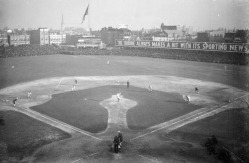
The distinct evolution of baseball from among the various bat-and-ball games is difficult to trace with precision. While there has been general agreement that modern baseball is a North American development from the older game rounders, the 2006 book Baseball Before We Knew It: A Search for the Roots of the Game, by David Block, argues against that notion. Several references to "baseball" and "bat-and-ball" have been found in British and American documents of the early eighteenth century. The earliest known description is in a 1744 British publication, A Little Pretty Pocket-Book, by John Newbery. It contains a wood-cut illustration of boys playing "base-ball," showing a baseball set-up roughly similar to the modern game, and a rhymed description of the sport. The earliest known unambiguous American discussion of "baseball" was published in a 1791 Pittsfield, Massachusetts, town bylaw that prohibited the playing of the game within 80 yards (70 m) of the town's new meeting house. The English novelist Jane Austen made a reference to children playing "base-ball" on a village green in her book Northanger Abbey, which was written between 1798 and 1803 (though not published until 1818).
The first full documentation of a baseball game in North America is Dr. Adam Ford's contemporary description of a game that took place in 1838 on June 4 (Militia Muster Day) in Beachville, Ontario, Canada; this report was related in an 1886 edition of Sporting Life magazine in a letter by former St. Marys, Ontario, resident Dr. Matthew Harris. In 1845, Alexander Cartwright of New York City led the codification of an early list of rules (the so-called Knickerbocker Rules), from which today's have evolved. He had also initiated the replacement of the soft ball used in rounders with a smaller hard ball. While there are reports of Cartwright's club, the New York Knickerbockers, playing games in 1845, the game now recognized as the first in U.S. history to be officially recorded took place on June 19, 1846, in Hoboken, New Jersey, with the "New York Nine" defeating the Knickerbockers, 23–1, in four innings.
History of baseball in the United States
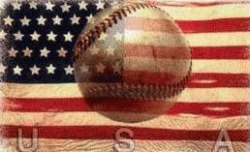
Semiprofessional baseball started in the United States in the 1860s; in 1869, the first fully professional baseball club, the Cincinnati Red Stockings, was formed and went undefeated against a schedule of semipro and amateur teams. By the following decade, American newspapers were referring to baseball as the "National Pastime" or "National Game." The first attempt at forming a "major league" was the National Association, which lasted from 1871 to 1875. The "major league" status of the NA is in dispute among present-day baseball historians, and Major League Baseball does not include the NA among the major leagues. The National League, which still exists, was founded in 1876 in response to the NA's shortcomings. Several other major leagues formed and failed, but the American League, which evolved from the minor Western League (1893) and was established in 1901 as a major league, succeeded. The two leagues were initially rivals that actively fought for the best players, often disregarding one another's contracts and engaging in bitter legal disputes. A modicum of peace was established in 1903, and the World Series was inaugurated that fall. The next year, however, the National League champion New York Giants did not participate as their manager, John McGraw, refused to recognize the major league status of the American League and its champion, the Boston Americans. The following year, McGraw relented and the Giants played the Philadelphia Athletics in the World Series. Compared with the present day, games in the early part of the 20th century were lower scoring and pitchers were more successful. The "inside game", whose nature was to "scratch for runs", was played more violently and aggressively than it is today. Ty Cobb said of his era especially, "Baseball is something like a war!" This period, which has since become known as the "dead-ball era", ended in the 1920s with several rule changes that gave advantages to hitters and the rise of the legendary baseball player Babe Ruth, who showed the world what power hitting could produce, altering the nature of the game. Two of the changes introduced were a move to bring the outfield fences closer to the infield in the largest parks, and an introduction of extremely strict rules governing the size, shape and construction of the ball, causing it to travel farther when hit; the aggregate result of these two changes was to enable batters to hit many more home runs. In 1884, African American Moses Walker (and, briefly, his brother Welday) had played for the Toledo Blue Stockings of the major league American Association. An injury ended Walker's major league career, and by the early 1890s, a "gentlemen's agreement" in the form of the baseball color line effectively barred African-American players from the majors and their affiliated minor leagues, resulting in the formation of several Negro Leagues. The first crack in the agreement occurred in 1946, when Jackie Robinson was signed by the National League's Brooklyn Dodgers and began playing for their minor league team in Montreal. Finally, in 1947, the major leagues' color barrier was broken when Robinson debuted with the Dodgers. Although the transformation was not instantaneous, baseball has since become fully integrated. Major League baseball finally made it to the West Coast of the United States in 1958, when the Brooklyn Dodgers and New York Giants relocated to Los Angeles and San Francisco respectively. The first American League team on the West Coast was the Los Angeles Angels, who were founded as an expansion team in 1961. Pitchers dominated the game in the 1960s and early 1970s. In the early 1970s the designated hitter (DH) rule was proposed. The American League adopted this rule in 1973, though pitchers still bat for themselves in the National League to this day. The DH rule now constitutes the primary difference between the two leagues. Despite the popularity of baseball, and the attendant high salaries relative to those of average Americans, the players have become dissatisfied from time to time, as they believed the owners had too much control and retained an unfair share of the money. Various job actions have occurred throughout the game's history. Players on specific teams occasionally attempted strikes, but usually came back when their jobs were sufficiently threatened. The throwing of the 1919 World Series, the "Black Sox scandal", was in some sense a "strike" or at least a rebellion by the ballplayers against a perceived stingy owner. But the strict rules of baseball contracts tended to keep the players "in line" in general. This began to change in 1966 when former United Steelworkers chief economist (and assistant to the president) Marvin Miller became the Baseball Players Union executive director. The union became much stronger than it had been previously, especially when the reserve clause was effectively nullified in the mid-1970s. Conflicts between owners and the players' union led to major work stoppages in 1972, 1981, and 1994. The 1994 baseball strike led to the cancellation of the World Series, and was not settled until the spring of 1995. During this period, as well, many of the functions — such as player discipline and umpire supervision — and regulations that had been administered separately by the two major leagues' administrations were united under the rubric of Major League Baseball. 1995 was the year Cal Ripken, Jr. played in his 2,131st consecutive game, breaking Lou Gehrig's record. The number of home runs increased dramatically after the strike. Mark McGwire and Sammy Sosa both surpassed Roger Maris's long-standing single season home run record in 1998. In 2001, Barry Bonds established the current record of 73 home runs in a single season. In 2007, Bonds became MLB's all-time home run leader, surpassing Hank Aaron's total of 755. Even though all three sluggers (McGwire, Sosa, and Bonds) have been accused in the steroid-abuse scandal of the mid-2000s, their feats did do a lot at the time to bolster the game's renewed popularity.
Baseball around the world
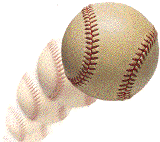
Baseball is largely known as America's pastime, but has a fan base in several other countries as well. The history of baseball in Canada has remained closely linked with that of the sport in the United States. As early as 1877, a professional league, the International Association, featured teams from both countries. While baseball is widely played in Canada, and many minor league teams have been based in the country, the American major leagues did not include a Canadian club until 1969, when the Montreal Expos joined the National League as an expansion team. In 1977, the expansion Toronto Blue Jays joined the American League. The Blue Jays won the World Series in 1992 and 1993, the first and still the only club from outside the United States to do so. In 2004, Major League Baseball relocated the Expos to Washington, D.C., where the team is now known as the Nationals. The first formal baseball league outside of the United States and Canada was founded in 1878 in Cuba, which maintains a rich baseball tradition and whose national team has been one of the world's strongest since international play began in the late 1930s. Professional baseball leagues began to form in other countries between the world wars, including the Netherlands (formed in 1922), Australia (1934), Japan (1936), and Puerto Rico (1938). After World War II, professional leagues were founded in Italy (1948) and in many Latin American nations, most prominently Venezuela (1945), Mexico (1945), and the Dominican Republic (1951). In Asia, Korea (1982), Taiwan (1990), and China (2003) all have professional leagues. Many European countries have pro leagues as well, the most successful beside the Dutch being the Italian league founded in 1948. Compared to those in Asia and Latin America, the various European leagues and the one in Australia historically have had no more than niche appeal. Recently, the sport has begun to grow in popularity in those nations, most notably in Australia, which won a surprise silver medal in the 2004 Olympic Games. In 2007, the Israel Baseball League, featuring six teams, was launched. Competition between national teams, such as in the Baseball World Cup and the Olympic baseball tournament, has been administered by the International Baseball Federation since its formation in 1938. As of 2004, the organization has 112 member countries. Since the early 1970s, the annual Caribbean Series has matched the league-winning clubs from Puerto Rico, Venezuela, Mexico, and the Dominican Republic. The Confédération Européene de Baseball (European Baseball Confederation), founded in 1953, organizes a number of competitions between clubs from different countries as well as national squads. The inaugural World Baseball Classic, held in March 2006, had a much higher profile than previous tournaments featuring national teams, owing to the participation for the first time of a significant number of players from Major League Baseball. The 117th meeting of the International Olympic Committee, held in Singapore in July 2005, voted not to hold baseball and softball tournaments at the 2012 Summer Olympic Games, but they will remain Olympic sports during the 2008 Summer Olympic Games and will be put to vote again for each succeeding Summer Olympics. The elimination of baseball and softball from the 2012 Olympic program enabled the IOC to consider adding two different sports to the program, but no other sport received a majority of votes favoring its inclusion. While baseball's lack of substantial appeal in much of the world was a factor; more important is the unwillingness of Major League Baseball to have a break during the Games so that its players can participate, something that the National Hockey League now does during the Winter Olympic Games. Because of the seasonal nature of baseball and the high priority its fans place on the integrity of major-league statistics from one season to the next, it would be more difficult to accommodate such a break in Major League Baseball.
